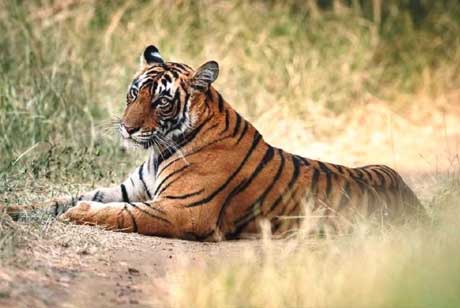Ranthambore National Park is located in the Sawai Madhopur district of Rajasthan. The national park, renowned for its significant tiger population is one of India's most preferred wildlife destinations. The national park's diverse landscape not only includes dense forests and waterbodies but also ancient ruins, making it a popular destination for wildlife enthusiasts and photographers. The Ranthambore Fort is one such attraction in Ranthambore National Park. Apart from the majestic Royal Bengal Tigers, tourists flock to Ranthambore to visit the Trinetra Ganesh Temple and the ruins of the ancient Ranthambore Fort.
About Ranthambore Fort
The renowned Ranthambore Fort, constructed by the Chauhan rulers in the 10th century, holds significant historical importance due to its strategic location, which made it an ideal defense against invaders. Presently, a UNESCO World Heritage Site, the fort is nestled inside the premises of Ranthambore National Park. One of the notable events in its history is the legendary act of ‘jauhar’ by royal women during Alauddin Khilji's invasion in 1303. The fort, built in 944 AD, is known for its grand architecture, featuring temples, tanks, imposing gates, and vast walls. Among the key historical events was the battle between Rao Hamir and Sultan Alauddin Khilji in 1301. The fort showcases several attractions, such as Toran Dwar, Mahadeo Chhatri, and Sametonki Haveli, reflecting its architectural splendor. The presence of both a mosque and a temple signifies the secular outlook of the Rajput rulers. A highlight is the Lord Ganesha temple, which draws many visitors and hosts an annual fair during Bhadrapad Sudi Chaturthi.
Ranthambore Fort covers a circumference of around 7 km. Though many structures have been lost to time and conflict, some notable remnants, such as Badal Mahal, Dullah Mahal, the 32 Pillared Chhatri, and Hammir's Court, still showcase the fort's former grandeur. The fort also houses cenotaphs, mosques, temples, barracks, step-wells, and gates. Scattered ruins and remnants of walls serve as silent reminders of its rich history. For water, the fort relies on two rain-fed reservoirs, and its massive stone walls, strengthened by towers and bastions, were built using locally sourced stone.


The Significant Spiritual Spot of Ranthambore Fort
The Trinetra Ganesha Temple stands as a major attraction within the fort, drawing thousands of visitors from across the country who come to seek the Lord's blessings for happiness and prosperity. Wednesdays, dedicated to Lord Ganesh, are particularly popular, with many locals visiting the temple. An intriguing tradition involves the local postman delivering daily mail addressed to Lord Ganesha, predominantly consisting of wedding invitations. Additionally, the fort serves as an excellent location for bird watching, hosting a variety of bird species, as well as langurs, occasional small cats, and the elusive fishing cat.
Architecture of the Ranthambore Fort
Ranthambore Fort features a collection of intricately carved temples, palaces, and gates, accessible through seven distinct entrances. Among these, Navlakha Pol, positioned to the east, is notable for its copper plate inscribed with historical details. Another eastern gate, Suraj Pol, is the smallest of the fort’s entrances. On the southern side, Ganesh Pol and Sat Pol provide access, while Andheri Pol, Hathi Pol, and Delhi Pol serve the northern, southeastern, and northwestern sides, respectively.
The fort displays various signs and symbols of the ruling dynasties, including the Mughals, and is surrounded by an array of stone pathways, robust walls, water tanks, palaces, and temples, all constructed from locally sourced stone. Noteworthy structures within the fort include Bada Mahal, Hammir Court, Dhula Mahal, and Phansi Ghar. Other attractions are Toran Dwar, Mahadeo Chhatri, and Sametonki Haveli. The Trinetra Ganesha Temple, renowned for depicting Lord Ganesh with a third eye, is a prominent feature.
The fort displays various signs and symbols of the ruling dynasties, including the Mughals, and is surrounded by an array of stone pathways, robust walls, water tanks, palaces, and temples, all constructed from locally sourced stone. Noteworthy structures within the fort include Bada Mahal, Hammir Court, Dhula Mahal, and Phansi Ghar. Other attractions are Toran Dwar, Mahadeo Chhatri, and Sametonki Haveli. The Trinetra Ganesha Temple, renowned for depicting Lord Ganesh with a third eye, is a prominent feature.